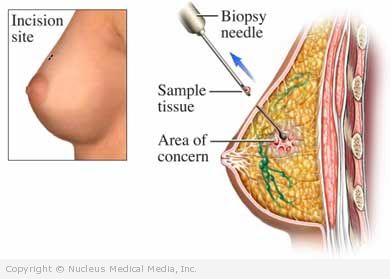Fine needle biopsy
Fine needle biopsy – Definition
A biopsy is used to remove a tissue sample. The sample is examined for abnormal cells, disease, or infection. In a fine needle biopsy (FNB), fluid and cells are removed using a thin, hollow needle.
Fine needle biopsy – Reasons for Procedure
This biopsy is used to evaluate organ or tumor tissue. It is also sometimes used to find out how certain treatments are working.
Fine needle biopsy – Possible Complications
Complications are rare, but no procedure is completely free of risk. The potential complications will depend on the location of the biopsy. Your doctor will review a list of possible complications, which may include:
- Bleeding
- Bruise where the needle was inserted
- Pain after the procedure
- Infection
Factors that may increase the risk of complications include:
- Smoking
Fine needle biopsy – What to Expect
Prior to Procedure
Ask your doctor if there are any instructions you should follow before the procedure. Depending on the part of the body that the biopsy is being taken from, your doctor may ask you to:
- Drink contrast material.
- Have routine blood work.
- Arrange for a ride home.
Talk to your doctor about your medicines. You may be asked to stop taking some medicines up to one week before the procedure, like:
- Aspirin or other anti-inflammatory drugs
- Blood thinners, such as clopidogrel (Plavix) or warfarin (Coumadin)
Fine needle biopsy – Anesthesia
Local anesthesia is often used. It will make the area numb. A sedative may also be used to help you relax.
Fine needle biopsy – Description of the Procedure
Depending on the biopsy site, an ultrasound, x-ray, or computed tomography (CT) scan may be used to help guide the needle.
You will be positioned for the easiest access to the area for biopsy. The skin will be swabbed with a cleaning solution. Anesthesia will be applied to numb the area. You will be asked to stay still. A thin, hollow needle will then be inserted through the skin to the site. The needle may need to be inserted more than once. Once the needle is in the proper position, tissue or fluid will be withdrawn. You may feel a pinch, pressure, or nothing at all. You may be monitored for bleeding or other complications. The site will be bandaged.
Fine needle biopsy – How Long Will It Take?
- Simple biopsy (site is close to surface of skin): a few minutes (in most cases)
- Deeper biopsy or one that is guided by an ultrasound or CT scan: 30-90 minutes
Fine needle biopsy – Will It Hurt?
The amount of discomfort you feel depends on the part of the body that is being examined. The anesthesia and sedative will prevent pain. You may feel a pinch or pressure. If you feel pain, tell the doctor right away. After the procedure, the site will be tender.
Fine needle biopsy – Post-procedure Care
Be sure to follow your doctor’s instructions. In general, you should check the insertion site and keep it clean.
The sample will be examined by a specialist. The results are usually ready in a few days. Your doctor will talk to you about the results.
Fine needle biopsy – Call Your Doctor
After arriving home, contact your doctor if any of the following occurs:
- Signs of infection, including fever and chills
- Pain, redness, swelling, heat, discharge, or a red streak in the area of the needle insertion
- Cough, shortness of breath, or chest pain
- New symptoms develop
In case of an emergency, call for medical help right away.

